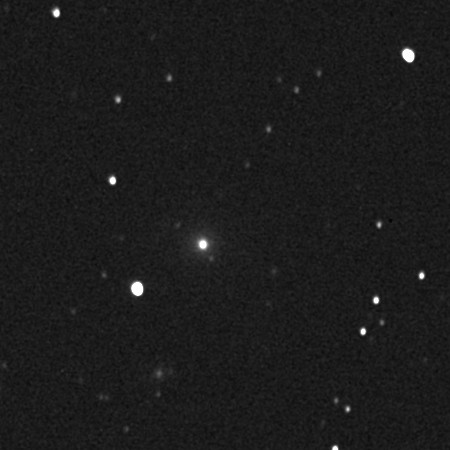Please click here for Macedonian translation:
Circular from International Astronomical Union (2011 January 3)
SUPERNOVA 2010lt IN UGC 3378
David J. Lane, Stillwater Lake, NS, Canada; and K. A. Gray and Paul Gray, Birdton, NB, Canada, report their discovery of an apparent supernova (mag about 17.0) on an unfiltered CCD image taken with a 0.36-m f/5.5 telescope on 2010 Dec. 31.921 UT, with a confirming image taken by Brian Tieman (Streator, IL, U.S.A.) showing the new object at mag about 17 on 2011 Jan. 2.990. The new object is located at R.A. = 6h06m09s.18, Decl. = +83o50'28".8 (equinox 2000.0), which is about 20" west and 10" north of the nucleus of the galaxy UGC 3378. Nothing is visible at this position on unfiltered CCD images taken by Lane with a 0.28-m C11 telescope (+ ST9 camera) on 2005 Oct. 31 (limiting mag approximately 18.0), 2006 Jan. 5 (limiting mag approximately 18.3), and 2006 Mar. 29 (limiting mag approximately 18.5); also, nothing is visible at the position of 2010lt on digitized Palomar Sky Survey red, infrared, and blue images.

before /after photos
RASC Official Press Release
Ten-year-old New Brunswick Girl Discovers Exploding Star
Toronto, Canada (January 3, 2011) – The Royal Astronomical Society of Canada (RASC) is pleased to announce the discovery of a supernova by a ten-year-old amateur astronomer—the youngest person ever to have made such a discovery.
Ten-year-old Kathryn Aurora Gray of Fredericton, New Brunswick under the watch of astronomers, Paul Gray and David Lane, are pleased to report the discovery of a magnitude 17 supernova in galaxy UGC 3378 in the constellation of Camelopardalis, as reported on IAU Electronic Telegram 2618. The galaxy was imaged on New Year's Eve 2010, and the supernova was discovered on January 2, 2011 by Kathryn Aurora Gray and Paul Gray.
Supernovas are stellar explosions that signal the violent deaths of stars several times more massive than our sun. Supernovas are interesting to astronomers because they manufacture most of the chemical elements that went into making the earth and other planets, and also because distant supernovas can be used to estimate the size and age of our universe.
Supernovas are rare events. The last one in our galaxy occurred several hundred years ago, before the invention of the telescope. The odds of discovery can be increased by repeatedly checking many other galaxies. A new supernova reveals itself as a bright point of light that wasn't there the last time the galaxy was checked. Since a supernova can outshine millions of ordinary stars it is easy to spot with a modest telescope, even in a distant galaxy like UGC 3378 which is about 240 million light-years away.
The discovery was soon verified by Illinois-based amateur astronomer Brian Tieman and Arizona-based Canadian amateur astronomer Jack Newton. It was then reported to the International Astronomical Union's Central Bureau for Astronomical Telegrams. This is Mr. Lane’s fourth supernova discovery, Mr. Gray's seventh, and Kathryn's first!
Details abut the discovery, and the observatory from which it was made, can be found here: http://www.abbeyridgeobservatory.ca/research/supernova-discoveries/118-supernova-sn2010lt
Founded in 1868, the Royal Astronomical Society of Canada is Canada's leading astronomy organization bringing together 4,000+ enthusiastic amateurs, educators and professionals. RASC and its 29 Centres across Canada offer both national and local programming and services. The RASC’s vision is to inspire curiosity in all Canadians about the universe, to share scientific knowledge, and to foster collaboration in astronomical pursuits.
-30-
For more information contact:
Deborah Thompson
Royal Astronomical Society of Canada
888-924-7272 thompson@rasc.ca This e-mail address is being protected from spambots. You need JavaScript enabled to view it
|

